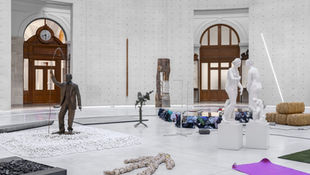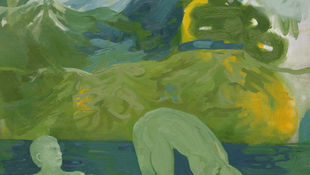
The Lalannes and Decorative Objects
In the long-standing dialogue between form and function, the work of François-Xavier and Claude Lalanne offers an exceptional case study. Rejecting the industrial rigidity and minimalism often associated with 20th-century modernism, the Lalannes crafted whimsical yet meticulously executed objects that serve both sculptural and utilitarian roles. Their designs - ranging from François-Xavier's iconic sheep sculptures that double as seating to Claude's intricately cast botanical forms - defy simple classification. This article aims to examine the philosophical, historical, and artistic implications of Lalanne’s design, arguing that their practice constitutes a re-enchantment of everyday life through the lens of surrealist materiality.

François-Xavier Lalanne (1927–2008) and Claude Lalanne (1924–2019) met in Paris in the 1950s and became lifelong collaborators and partners. Their practice began to gain traction in the 1960s, a period marked by the waning of strict modernist dogmas and the emergence of more pluralistic approaches to design. Educated in painting and sculpture, the Lalannes diverged from the dominant minimalist trends that privileged abstraction and seriality. Instead, they embraced a richly figurative language rooted in mythology, flora, fauna, and dream logic. The historical positioning of their work aligns more closely with movements such as Art Nouveau and Surrealism than with the Bauhaus or International Style. Their early support from figures like Yves Saint Laurent and Pierre Bergé, who collected and commissioned their work extensively, placed the Lalannes within the haute couture milieu of postwar Paris, where boundaries between art, fashion, and design were fluid.
At the core of Lalanne’s design is a deliberate ambiguity between function and sculpture. François-Xavier often described his work as “sculpture utilitaire” (functional sculpture), an oxymoron that reveals the conceptual tension within their work. For example, his Mouton de Laine (1965), a series of life-sized sheep covered in wool and mounted on wooden legs, functions as seating but evokes Arcadian and surrealist tropes simultaneously. Claude Lalanne's practice, in contrast, leaned toward botanical and corporeal forms rendered in metal. Her Ginkgo bench, Pomme de Ciel, and Choupatte (a cabbage with chicken legs) evoke both ancient myth and contemporary design. Her use of galvanoplasty — an electroplating process - allowed her to achieve an extraordinary fidelity to natural textures, suggesting a metaphysical intimacy with nature. Together, the Lalannes construct an aesthetic philosophy that may be termed "poetic functionality" - a design paradigm where utilitarian objects are transformed into conduits of wonder and narrative.
The craftsmanship behind Lalanne’s design is as integral as its iconography. François-Xavier primarily worked with bronze and patinated metals, often employing lost-wax casting to achieve lifelike detail in animal forms. His process involved an initial sculpting in clay or wax, which was then cast by skilled foundries such as Bocquel in France. Claude’s use of electroplating, in contrast, represents a more experimental and biomimetic approach. She frequently encased natural leaves, flowers, and even animals in copper, creating forms that captured the microstructure of organic material with scientific precision. This method allowed her to evoke a tangible connection between natural decay and artistic preservation. Their methods reflect a deep commitment to the artisanal in an age increasingly defined by mass production. In this way, the Lalannes also serve as critical interlocutors in the discourse surrounding craft revivalism and material authenticity in postmodern design.

The Lalannes' work is best understood through the lens of Surrealism, particularly the idea of the "marvellous" in the everyday. André Breton’s call for the reconciliation of dream and reality finds a literal manifestation in Lalanne’s pieces: a bureau shaped like a rhinoceros, a chandelier made of creeping vines, a bed sprouting cabbages. These dream-like dislocations produce what Hal Foster, following Freud, has termed the "uncanny" - a return of the repressed, made tangible in design. By integrating surreal forms into functional contexts, the Lalannes disturb and revitalise the user's relationship to the object world.Contemporary theoretical developments such as object-oriented ontology and new materialism also offer relevant lenses. Graham Harman's idea that objects possess a reality independent of human perception resonates with the autonomy and lifelike presence of Lalanne’s creations. Their pieces are not merely designed for use, but seem to possess an agency of their own, inviting the user into a relational, almost animistic experience with materiality.
Though long admired by elite collectors, the Lalannes experienced a significant market resurgence in the early 21st century. Sotheby’s and Christie’s auctions have seen their works fetch millions, culminating in the landmark sale of the Yves Saint Laurent and Pierre Bergé collection in 2009, which dramatically elevated their international profile. This market success, while affirming their artistic stature, also raises questions about the commodification of design and the shifting criteria of aesthetic value in the luxury art market. Lalanne pieces now occupy a space somewhere between collectable design and fine art, blurring categories in ways that mirror their formal strategies.
The Lalannes' influence can be traced across a range of contemporary designers and artists. Figures like Marc Newson, Studio Job, and the Haas Brothers have drawn upon their fusion of fantasy and functionality. Moreover, the growing prominence of "design art" as a category - represented in venues such as Design Miami/ and the Carpenters Workshop Gallery - owes much to the Lalannes' pioneering efforts. Their legacy also lives on through continued posthumous exhibitions and production by family-run studios, ensuring that their idiosyncratic vision continues to inspire new generations.
The design philosophy of François-Xavier and Claude Lalanne defies reductive classification. By merging sculpture with utility, surrealism with nature, and craftsmanship with concept, the Lalannes redefined what design could be. Their work constitutes a rare synthesis of humour, beauty, and precision - an aesthetic of enchantment that continues to resonate in an increasingly rationalised world. Through their art, the Lalannes invite us to reconsider the boundaries between the living and the made, the playful and the serious, the decorative and the essential.





